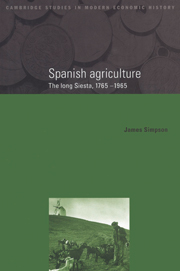Book contents
- Frontmatter
- Contents
- List of illustrations
- List of tables
- Acknowledgements
- Note on the regional division of Spain
- Abbreviations and conventions
- Introduction
- Part I The relative backwardness of Spanish agriculture
- Part II Traditional technologies and market opportunities, 1765–1880
- Part III The limits to technical change, 1880–1936
- Part IV Markets and institutions, 1880–1936
- 8 The growth of the home market and agricultural specialisation
- 9 Agricultural exports and the international economy
- 10 The political economy of Spanish agriculture
- Part V The State and the end of traditional agriculture
- Conclusion
- Appendix Estimates of agricultural output and consumption in nineteenth-century Spain
- Bibliography
- Index
10 - The political economy of Spanish agriculture
Published online by Cambridge University Press: 04 December 2009
- Frontmatter
- Contents
- List of illustrations
- List of tables
- Acknowledgements
- Note on the regional division of Spain
- Abbreviations and conventions
- Introduction
- Part I The relative backwardness of Spanish agriculture
- Part II Traditional technologies and market opportunities, 1765–1880
- Part III The limits to technical change, 1880–1936
- Part IV Markets and institutions, 1880–1936
- 8 The growth of the home market and agricultural specialisation
- 9 Agricultural exports and the international economy
- 10 The political economy of Spanish agriculture
- Part V The State and the end of traditional agriculture
- Conclusion
- Appendix Estimates of agricultural output and consumption in nineteenth-century Spain
- Bibliography
- Index
Summary
To an economist, whether soil is fertile or mediocre and whether resources are abundant or sparse will be determined not by intrinsic physical properties of the land, but by the level of demand, the state of knowledge, and the organization of property rights and markets.
It has been argued in this book that Spanish farmers responded positively to movements in commodity and factor prices. Decision-making, whether by small dairy farmers in Galicia, wine sharecroppers in Cataluña or latifundistas in Andalucía, seems to have been economically rational and based on information relating to the cost of factors, commodity prices and the degree of risk which each farmer thought appropriate. Yet, if farmers responded rationally to product and commodity prices, why was it that the sector's low productivity resulted in both high consumer prices and low farm incomes? Self-sufficiency was achieved in basic foodstuffs, but diets remained heavily concentrated on cereals, and farm incomes, if growing at all, remained low. In short, agriculture prior to the Civil War cannot be considered an overall success.
In chapter 8 I argued that cereal tariffs resulted in high food costs and that the impact of urbanisation and growing per capita incomes was limited for the livestock farmers on Spain's secano, because of poor pastures and expensive fodder crops.
- Type
- Chapter
- Information
- Spanish AgricultureThe Long Siesta, 1765–1965, pp. 221 - 240Publisher: Cambridge University PressPrint publication year: 1996



